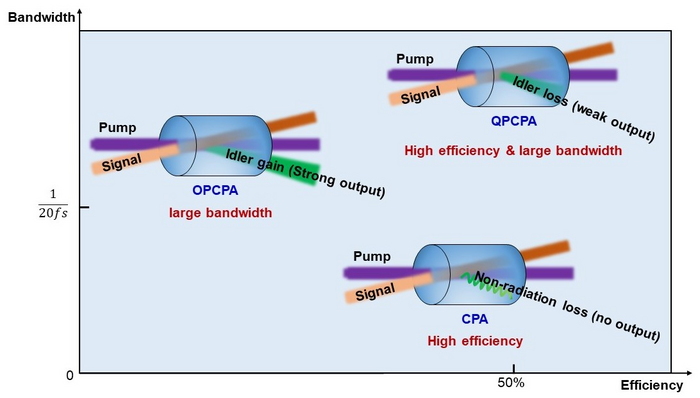Reviewed by Mila PereraSep 16 2022
Since the first presentation of chirped-pulse amplification (CPA) and optical parametric chirped-pulse amplification (OPCPA), femtosecond lasers have been able to provide ultrahigh peak powers reaching ten-petawatt (PW), thus making way for X-Ray sources and small particle accelerators.

In CPA, the pump amplifies the signal through an energy-level gain medium system in which one of the transitions is non-radiative. This kind of laser amplification has a high efficiency from the pump to signal and a relatively narrow gain bandwidth. In OPCPA, the pump amplifies the signal through parametric interaction and simultaneously generates the idler wave. OPCPA can be broadband by manipulating the phase-matching condition but suffers from a relatively low efficiency due to back conversion. QPCPA is a variation of OPCPA by dissipating the idler with strong crystal absorption. The idler dissipation obstructs the back conversion effect and enables both high efficiency and large bandwidth. Image Credit: Jingui Ma, Kainan Xiong, Peng Yuan, Xiaoniu Tu, Jing Wang, Guoqiang Xie, Yanqing Zheng, Liejia Qian
It also requires laser amplification arrangements with large bandwidth and high conversion efficiency to boost peak powers. However, CPA laser amplifiers endure comparatively narrow gain bandwidth, whereas OPCPAs have to endure comparatively low signal efficacy or pump depletion because of back conversion.
In a recent study, a team of scientists, headed by Professor Liejia Qian from Key Laboratory for Laser Plasmas (MOE), School of Physics and Astronomy, Shanghai Jiao Tong University, China, and co-workers have shown an ultra high-efficiency and low-noise scheme of QPCPA, which is a variant of OPCPA by dispersing the idler with robust crystal absorption.
Details of the study can be found in Light Science & Application.
The idler dissipation hinders the back conversion effect and allows the QPCPA performance of high efficiency, robustness, and large bandwidth against phase disparity. They experimentally showed 56% energy efficiency for an 810 nm signal changed from a 532 nm pump, or equally 85% pump depletion.
Such a record high reduction significantly inhibited the parametric superfluorescence (PSF) noise in QPCPA to only ~10-6 compared to the amplified signal energy.
In an experiment conducted by the researchers, an 8 cm Sm:YCOB crystal was employed with an orientation for optimized nonlinear coefficient, which was transparent for the pump and the signal but opaque for the idler.
Using a pump intensity of 3 GW cm−2, the maximum signal efficiency of 56% was accomplished with a seed intensity of ~7 MW cm−2, matching a pump depletion of 85%. The established QPCPA pump depletion was about 2.5 times that of OPCPA. The robust pump depletion by efficient signal amplification considerably blocked the production of PSF noise.
Within the major signal output of ~65 mJ, the calculated PSF noise energy was as low as ~10 μJ. The pulse contrast following compression must be as high as ~109. Prof. Jingui Ma, the study’s first author, clarified why they termed such a process ‘quasi-parametric’ amplification:
In the saturated amplification regime, its efficiency keeps increasing with the seed intensity without any back conversion, quite similar as ‘non-parametric’ laser amplification. However, in the small-signal amplification regime, it inherits all the parametric behaviors of OPCPA. The QPCPA combines the merits of parametric and non-parametric processes.
Prof. Jingui Ma, Study First Author, Key Laboratory for Laser Plasmas (MOE), CICIFSA, School of Physics and Astronomy, Shanghai Jiao Tong University
“Since the back-conversion effect is completely obstructed, the QPCPA is also robust against phase mismatch. This means that QPCPA is insensitive to the variation of pump beam pointing and the environment temperature. This benefits the high repetition-rate operation of QPCPA.” Prof. Ma added.
With its very large product of efficiency and bandwidth, the QPCPA scheme based on a large-size Sm:YCOB crystal can support a peak power as high as 50 PW by using the same pump energy of current ten-petawatt laser facilities, so QPCPA may be a qualified candidate for pushing ultraintense lasers beyond the current ten-petawatt limit.
Prof. Jingui Ma, Study First Author, Key Laboratory for Laser Plasmas (MOE), CICIFSA, School of Physics and Astronomy, Shanghai Jiao Tong University.
Journal Reference
Ma, J., et al. (2022) Demonstration of 85% pump depletion and 10−6 noise content in quasi-parametric chirped-pulse amplification. Light Science & Application. doi.org/10.1038/s41377-022-00967-6.